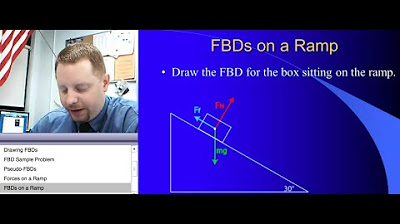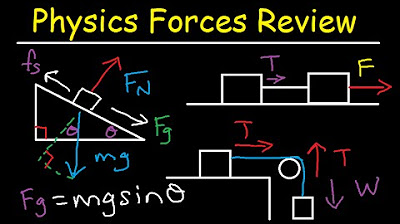Newton's Laws - Problem Solving
TLDRThis video tutorial delves into applying Newton's laws of motion to solve physics problems. It outlines a step-by-step approach, emphasizing the importance of drawing Freebody diagrams, choosing appropriate axes, and resolving forces into components. The video illustrates these concepts with examples involving inclined planes, pulleys, and collisions, demonstrating how to calculate acceleration and forces. It also addresses the impact of acceleration on perceived weight in scenarios like elevator rides and freefalling elevators, offering insights into apparent weightlessness.
Takeaways
- 📚 Newton's Laws of Motion are fundamental for solving physics problems involving forces and motion.
- 🎯 The first step in problem-solving with Newton's laws is to draw a Freebody diagram for each object involved, showing only the forces acting on the object, not exerted by it.
- 📐 Choosing appropriate x and y axes can simplify calculations, especially when dealing with inclined planes or other non-standard orientations.
- 🔄 When analyzing systems with multiple objects, define a positive direction of motion that applies to all objects for consistency.
- 💥 Resolve forces into their x and y components to apply Newton's second law (F_net = m*a) to each direction separately.
- 📈 For inclined planes, rotate the axes so that the x-axis is along the incline and the y-axis is perpendicular to it, simplifying the analysis.
- 🔧 Newton's second law is applied to each component (x and y) for each object in the problem to find accelerations and forces.
- 🔄 Action and reaction forces (Newton's third law) are equal in magnitude and opposite in direction, but their representation in equations accounts for their directions.
- 🧬 In problems with pulleys and hanging masses, the acceleration of the system can be found by summing the forces and applying Newton's second law to the combined mass.
- 🚗 In collisions, use kinematics to find the acceleration before applying Newton's laws to determine the forces involved.
- 🛠️ The apparent weight on a scale changes with the acceleration of the elevator, increasing with upward acceleration and decreasing with downward acceleration, becoming zero in freefall.
Q & A
What are the steps to solve physics problems using Newton's laws of motion?
-The steps include: 1) Draw a Freebody diagram for each object involved, showing only the forces acting on the object. 2) Choose appropriate x and y axes that simplify the calculation. 3) Define the positive direction of motion for each object. 4) Resolve forces into their x and y components. 5) Apply Newton's second law separately for each component and for each object.
Why is it important to draw Freebody diagrams when solving physics problems with Newton's laws?
-Freebody diagrams are crucial because they visually represent all the forces acting on an object, excluding the forces the object is exerting on others. This helps in isolating the object and analyzing the net forces acting on it, which is essential for applying Newton's laws accurately.
How does the choice of axes affect the analysis of a problem in Newton's laws?
-The choice of axes can significantly simplify the problem. For instance, in the case of an object on an incline, rotating the axes so that the x-axis is along the incline and the y-axis is perpendicular to it can make the analysis much easier because it aligns the forces more naturally with the axes, reducing the complexity of the calculations.
What is the significance of defining the positive direction of motion when solving problems with Newton's laws?
-Defining the positive direction of motion is important because it establishes a consistent reference for the analysis. It ensures that all components of motion are analyzed in the same direction, which is necessary for accurate application of Newton's second law and for calculating accelerations and forces correctly.
How do you calculate the acceleration of an object when a force is applied at an angle?
-To calculate the acceleration when a force is applied at an angle, you need to resolve the force into its components along the x and y axes. The x-component of the force is given by the force magnitude times the cosine of the angle (Fa cos θ), and the y-component by the force magnitude times the sine of the angle (Fa sin θ). Then, apply Newton's second law for each component (Fnet_x = m * ax and Fnet_y = m * ay) to find the accelerations in each direction.
What is the role of Newton's second law in solving physics problems?
-Newton's second law, which states that the net force on an object is equal to the mass of the object times its acceleration (Fnet = m * a), is fundamental in solving physics problems. It allows us to calculate the acceleration of an object when the net force and mass are known, and it forms the basis for analyzing the motion of objects under various force conditions.
How does the absence of friction affect the analysis of a physics problem?
-In the absence of friction, the analysis is simplified because one of the common forces affecting motion is not present. This means that the net force acting on an object is easier to calculate, as you only need to consider the applied forces and the gravitational force, without the need to account for frictional forces that would otherwise oppose motion or cause additional accelerations.
What is the concept of action and reaction pairs in Newton's third law?
-Newton's third law states that for every action, there is an equal and opposite reaction. This means that the forces two objects exert on each other are equal in magnitude and opposite in direction. These action-reaction pairs do not cancel each other out because they act on different objects, but they are important to consider when analyzing the dynamics of a system involving multiple objects.
How does the weight of a person change when they are in an accelerating elevator compared to when they are at rest?
-When a person is in an elevator that is accelerating upwards, they appear to weigh more than when the elevator is at rest. This is because the normal force exerted by the elevator on the person increases to counteract both the force of gravity and the upward acceleration. If the elevator is accelerating downwards, the person would appear to weigh less, as the normal force decreases due to the negative acceleration.
What is the concept of apparent weightlessness, and how does it relate to the physics of an elevator in freefall?
-Apparent weightlessness occurs when the force exerted on an object is zero, making it seem as if there is no gravity acting on it. In the case of an elevator in freefall, both the elevator and its occupants are accelerating downwards at the same rate, so the normal force (the force that would normally press them against the elevator floor) becomes zero. This results in a state of freefall where objects inside the elevator, including people, experience weightlessness.
How does the tension in a rope differ from the force of gravity on an object?
-The tension in a rope is the force that the rope exerts at each end. It is a transmitted force that acts along the length of the rope. In contrast, the force of gravity on an object is a fundamental force that acts vertically downwards towards the center of the Earth. Tension can vary depending on the situation and the forces acting on the rope, while gravity is a constant force that an object experiences regardless of its state of motion.
Outlines
📚 Introduction to Newton's Laws for Problem Solving
This paragraph introduces the use of Newton's laws of motion in solving physics problems. It emphasizes the importance of following specific problem-solving steps, beginning with drawing a Freebody diagram for each object involved. The video script explains that Freebody diagrams illustrate only the forces acting on an object, not the forces exerted by the object on others. The second step is choosing axes that simplify calculations, with an example provided using an object on an incline. The paragraph also discusses defining the positive direction of motion for objects in a system, such as a pulley with two masses, and the necessity of resolving forces into their x and y components before applying Newton's second law to find the net force and acceleration for each component of each object.
📐 Applying Newton's Second Law: Components and Freebody Diagrams
The paragraph delves into the application of Newton's second law, focusing on breaking down forces into their x and y components. It provides a worked example involving a 1.2 kg block being pulled with a 3 Newton force, explaining how to draw the Freebody diagram, resolve the applied force into components, and use Newton's second law to calculate acceleration and the normal force. The explanation includes the use of trigonometric relationships to find the components of the force and the importance of solving algebraically before substituting numerical values. The paragraph also introduces the concept of action-reaction pairs in Newton's third law, as applied to the forces between two interacting objects.
🔢 Solving for Unknowns in Newton's Laws
This section of the script discusses the process of solving for unknowns using Newton's laws. It uses an example of two blocks with different masses interacting and introduces the notation for the forces between them. The paragraph explains how to draw Freebody diagrams for each block, apply Newton's second law in the X direction, and solve the resulting equations to find the force exerted by one block on the other and the overall acceleration. The explanation highlights the relationship between action-reaction forces and how they cancel each other out when solving equations, leading to a clearer understanding of the forces involved in the interaction.
🧵 Conceptual Understanding of Tension in a Rope
The paragraph focuses on the conceptual understanding of tension in a rope, distinguishing it from the total weight of objects. It addresses a common misconception about the tension using a hypothetical question format. The explanation clarifies that tension is the force a rope exerts at each end and is equal to the weight of the object it is attached to, not the combined weight of multiple objects. The paragraph uses an example of two identical masses connected by a rope to demonstrate that the tension is equal to the weight of one mass, dispelling the idea that tension is double the weight of one object.
🔄 System Dynamics with Pulley and Masses
This paragraph explores the dynamics of a system involving two masses connected by a pulley, emphasizing the need to define a positive direction for both masses. It outlines the process of drawing Freebody diagrams for each mass, identifying the net force in the Y direction, and using Newton's second law to derive equations for the system's acceleration and the tension in the rope. The explanation shows how to solve these equations to find the acceleration and tension, taking into account the direction of acceleration and the relationship between the masses' accelerations. The paragraph also touches on the concept of apparent weightlessness when the system is in freefall.
🚗 Collision Analysis: Car and Brick Wall
The paragraph presents a detailed analysis of a car colliding with a brick wall, using kinematics to determine the car's acceleration during the collision. It explains how to use the given initial and final velocities, along with the stopping distance, to calculate the car's deceleration. The script then applies Newton's second law to find the force exerted by the brick wall on the car, illustrating the process with a step-by-step calculation that leads to the magnitude of the force. The explanation also discusses the implications of the符号 (symbols) used in physics to represent magnitudes and directions of forces.
🛗 Elevator Dynamics and Apparent Weightlessness
This section discusses the dynamics of a person in an accelerating elevator and the concept of apparent weightlessness. It explains how the scale reading reflects the normal force, which is influenced by the elevator's acceleration. The paragraph uses an example of a 75 kg person in an accelerating elevator to calculate the scale's reading and contrasts this with the situation when the elevator is in freefall, leading to apparent weightlessness. The explanation connects this phenomenon to the experience of astronauts in space, highlighting that the force of gravity is still present but not felt due to the lack of resistance or support from the environment.
Mindmap
Keywords
💡Newton's Laws of Motion
💡Freebody Diagram
💡Acceleration
💡Force
💡Net Force
💡Trigonometry
💡Mass
💡Incline
💡Pulley
💡Tension
Highlights
Newton's laws of motion are essential for solving physics problems involving forces.
Freebody diagrams are crucial for visualizing the forces acting on an object, excluding forces the object exerts on others.
Choosing appropriate x and y axes can simplify calculations, especially for inclined planes.
Defining a positive direction of motion is necessary for consistent analysis of system motion.
Forces should be resolved into their x and y components when not aligned with the axes.
Newton's second law is applied separately to each component (x and y) for each object involved.
An example demonstrates how to calculate acceleration and normal force on a box pulled with an angled force.
The net force in a direction is the sum of the components of all forces acting in that direction.
The example of a block sliding down an incline illustrates the importance of axis choice for problem-solving.
Action and reaction forces (Newton's third law) are equal in magnitude and opposite in direction, but their signs depend on the chosen positive direction.
Tension in a rope is the force it exerts at each end, transferring force between objects.
The weight a person feels on a scale in an accelerating elevator changes due to the additional normal force.
In freefall, objects experience apparent weightlessness as there is no normal force exerted on them.
A car colliding with a wall exemplifies how kinematics can be used to find acceleration, which then helps determine the force.
The force exerted by the brick wall on a car in a collision can be calculated using the car's change in velocity and mass.
Understanding the interaction between objects, such as pulleys and hanging masses, requires analyzing the forces and accelerations involved.
When solving physics problems, it's important to break down complex scenarios into manageable steps and components.
The video provides a comprehensive guide on applying Newton's laws to a variety of physics problems, enhancing problem-solving skills.
Transcripts
Browse More Related Video

Free Body Diagrams - Tension, Friction, Inclined Planes, & Net Force

High School Physics - Ramps and Inclines

Static & Kinetic Friction, Tension, Normal Force, Inclined Plane & Pulley System Problems - Physics

College Physics 1: Lecture 17 - Weight, Apparent Weight, and Normal Force

AP Physics 1 - Elevators

College Physics 1: Lecture 15 - Equilibrium and Newton's Second Law
5.0 / 5 (0 votes)
Thanks for rating: